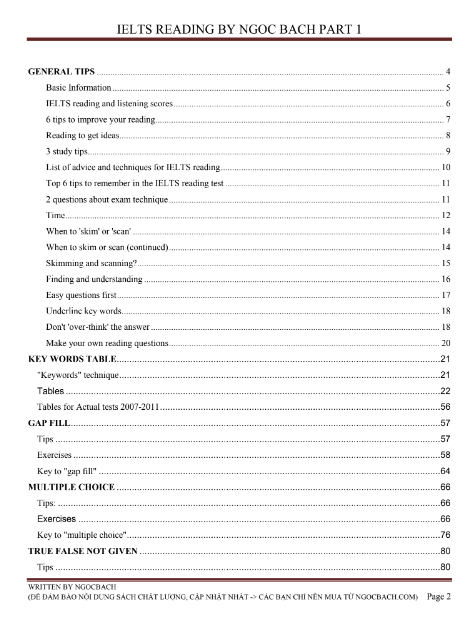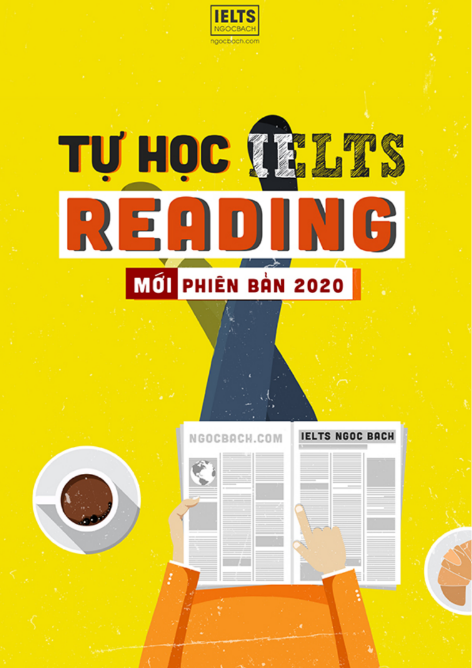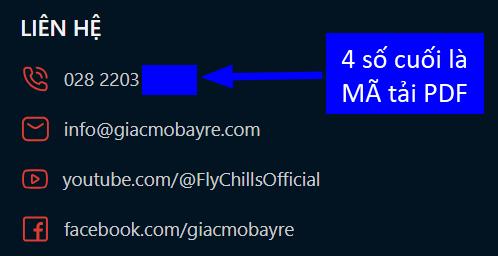


Basic Information
The Reading Test is immediately after the Listening Test at 10.40am. You do not get a break.
There are 3 sections in the Reading Test. Each section has 13 or 14 questions, making 40 questions in total.
The test lasts 60 minutes, and in that time you must write your answers on an answer sheet.
Here are some of the problems students have with IELTS Reading:
• Time is the biggest problem. Many students don’t manage to finish the test.
• The texts are long and contain some difficult vocabulary.
• Students find “paragraph headings” questions difficult.
• Students find “true/ false/ not given” questions difficult.
IELTS Reading is really a test of your vocabulary. If your knowledge of English words and phrases is good, you will do well.
There are techniques that can help you to work faster and cope with the difficult question types. However, the best way to improve your IELTS Reading score is by doing a lot of reading and vocabulary work.
Dịch đại ý
Thông tin cơ bản
Bài thi Đọc sẽ diễn ra ngay sau bài thi Nghe và không có thời gian nghỉ.
Sẽ có 3 phần trong một bài thi. Mỗi phần khoảng 13 đến 14 câu hỏi, tổng 3 phần là 40 câu hỏi. Bài thi kéo dài 60 phút và bao gồm cả thời gian ghi câu trả lời của bạn vào tờ đáp án.
Một số vấn đề cần chú ý trong Bài thi Đọc:
• Thời gian là vấn đề lớn nhất. Có nhiều thí sinh đã không kịp làm bài.
• Bài đọc dài và chứa nhiều từ vựng khó.
• Các thí sinh thường thấy dạng bài “paragraph headings” (chọn tiêu đề từng đoạn) và “true/ false/ not given” (chọn đúng/ sai) là những dạng bài khó.
Bài thi Đọc là bài thi kiểm tra từ vựng của bạn. Nếu bạn có kiến thức tốt về từ ngữ Tiếng Anh, bạn sẽ làm bài tốt.
Có một số kỹ thuật làm bài để bạn có thể làm nhanh hơn và có cách giải quyết cho một số dạng câu hỏi khó. Tuy nhiên, cách tốt nhất để cải thiện điểm thi Đọc là đọc nhiều và làm nhiều bài tập về từ vựng.
IELTS reading and listening scores
Students often ask how many correct answers they need (out of 40) to get a band score of 7 in the reading and listening tests.
According to official IELTS guidelines:
• Band 6 is about 23 out of 40
• Band 7 is about 30
• Band 8 is about 35
Note:
The score needed for each band can change depending on the difficulty of each test. If you have a really difficult test, the score needed for band 7 might be 28 or 29. If the test is easier, you might need to score 31 or 32 to get a 7.
Dịch đại ý
Điểm thi Đọc và Nghe
Học sinh học IELTS thường hỏi về số câu trả lời đúng cần thiết trên tổng số 40 để có được điểm 7 trong bài thi Đọc và Nghe.
Theo hướng dẫn chính thức của kì thi IELTS:
• Điểm 6: khoảng 23/40
• Điểm 7: khoảng 30/40
• Điểm 8: khoảng 35/40
Lưu ý:
Số điểm cần thiết cho mỗi mức điểm có thể thay đổi tùy vào độ khó của mỗi bài thi. Nếu bạn gặp phải đề thi thực sự khó, số điểm cần thiết cho điểm 7 có thể là 28 hoặc 29 câu trả lời đúng. Nếu bài thi dễ hơn, bạn có thể cần 31 đến 32 câu để được điểm 7.
Page 7
6 tips to improve your reading
How can you improve your reading? Here are 6 tips:
- If you want to improve your reading, the first thing to do is read a lot. There are no shortcuts or secret techniques; you will only improve with time and practice.
- Anything you read in English is good practice, so read about subjects that interest you. Try to enjoy reading in English.
- English is the most used language on the Internet. Whenever you search for information on the net, try searching in English first.
- Remember that “understanding is not the same as using”. Keep a notebook with useful words and phrases that you find when you’re reading, and try using them in your own sentences.
- Apart from reading things that interest you, you also need to read lots of IELTS passages. If you’ve done all of the tests in the Cambridge books, read the passages again without doing the questions. Use a dictionary, take notes, and try to fully understand each passage.
- Another way to use the Cambridge tests is to look at the correct answers to each question first. Your task is to find out why those answers are correct by analysing the passage carefully and finding the ‘keywords’.
I’m sure you can think of other suggestions. Be creative with your reading practice, try to enjoy the learning process, and trust that you will improve if you persist.
Dịch đại ý
6 bí quyết để tăng điểm Reading
- Nếu bạn muốn cải thiện kỹ năng đọc, việc đầu tiên là phải đọc thật nhiều. Không có đường tắt cũng như bí quyết bí mật nào cả, bạn chỉ có thể cải thiện qua thời gian và luyện tập.
- Bất kỳ cái gì bạn đọc bằng Tiếng Anh đều tốt, nên hãy đọc về những chủ đề mà bạn hứng thú. Cố gắng tìm thấy niềm vui trong việc đọc Tiếng Anh.
- Tiếng Anh là ngôn ngữ được sử dụng nhiều nhất trên mạng Internet. Bất kỳ khi nào bạn muốn tìm thông tin trên mạng, hãy thử sử dụng Tiếng Anh trước.
- Hãy nhớ rằng “hiểu được nó không đồng nghĩa với việc dùng được nó”. Hãy dùng 1 quyển sổ ghi lại những từ và cụm từ hữu ích mà bạn đọc được, và cố gắng dùng chúng trong câu văn của chính bạn.
- Ngoài việc đọc những gì bạn thích, bạn cũng cần đọc nhiều bài đọc IELTS. Nếu đã làm hết các bài trong sách Cambridge, hãy đọc lại các bài đọc mà không cần quan tâm tới câu hỏi. Dùng từ điển, ghi chú lại và cố gắng hiểu hoàn toàn các bài đọc.
- Một cách khác để dùng sách Cambridge là nhìn vào đáp án đúng trước, rồi cố gắng tìm cách phân tích tại sao đáp án này là đúng bằng cách phân tích bài đọc thật kỹ và tìm ra các từ khóa.
Tôi chắc chắn bạn có thể nghĩ ra nhiều cách khác nữa, cứ thoải mái sáng tạo cách học của riêng bạn và tin rằng nếu bạn kiên trì bạn sẽ thành công.
Page 8
Reading to get ideas
You shouldn’t think that reading practice is only useful for the reading test. Reading articles in newspapers, magazines or online is also a great way to improve your vocabulary knowledge and collect ideas for the writing and speaking tests.
For example, a recent question in the writing test asked whether or not it’s useful to study history. I did a quick search online and found an article.
You don’t need to read the full article, but it would be useful to note down some of the main ideas. Can you find 3 arguments against studying history, and 3 reasons why we should study it?
Dịch đại ý
Đọc để lấy ý tưởng
Bạn không nên nghĩ việc đọc chỉ hữu ích cho bài thi đọc. Đọc các bài báo, tạp chí, hay các bài viết trên mạng là cách rất tốt để nâng cao từ vựng và xây dựng ý tưởng cho bài thi viết và nói.
Ví dụ, một câu hỏi gần đây của bài thi viết là việc học lịch sử có cần thiết hay không. Tôi đã tìm kiếm nhanh trên mạng và tìm được một bài báo.
Bạn không cần thiết đọc hết cả bài, nhưng sẽ có ích nếu bạn ghi lại một số ý chính. Bạn có thể tìm được 3 lí do tại sao không cần học lịch sử, và 3 lí do tại sao ta nên học môn học này.
Page 9
3 study tips
Here are 3 study tips to help you improve your reading:
- As I said in Saturday’s lesson, the best way to get better at the reading test is by doing more reading. Do as many practice tests as you can, and read other things e.g. books, newspapers and online articles.
- Try doing a reading test without a time limit, and with a dictionary. If you still can’t get the score you need, you’ll need to look carefully at what you are doing wrong.
- Spend time analysing your mistakes and the correct answers. If you don’t understand why an answer was right or wrong, ask a teacher to help you. You’ll improve more quickly if you learn from your mistakes.
Dịch đại ý
3 bí quyết học
- Như tôi đã nói trong bài học vào Thứ 7, cách tốt nhất để cải thiện điểm đọc là đọc nhiều hơn nữa. Làm các bài thi thật càng nhiều càng tốt, và đọc cả những tài liệu khác như sách, báo và các bài viết trên mạng.
- Thử làm bài kiểm tra mà không có giới hạn thời gian và sử dụng từ điển. Nếu bạn vẫn không thể có được số điểm bạn muốn, bạn cần xem xét kỹ lưỡng xem mình đang sai ở đâu.
- Dành thời gian phân tích lỗi sai và những câu trả lời đúng. Nếu bạn không hiểu được tại sao đáp án là đúng hay sai, hãy nhờ một giáo viên giải đáp cho bạn. Bạn sẽ tiến bộ rất nhanh bằng cách học từ những sai lầm.
Page 10
List of advice and techniques for IELTS reading
Here is my list of advice and techniques for IELTS reading:
- Don’t read the whole text; you haven’t got enough time. Just go straight to the questions.
- ‘Paragraph’ questions are much easier if you do them last. Do other sections first.
- The answers to most questions should be in the correct order in the text, so you don’t need to go back to the beginning to start looking for the next answer.
- Read all instructions carefully.
- Look for ‘keywords’. There are usually words in the questions that are similar to words you need to find in the text. For example, if the text contains the word “global”, the question might use the word “international”. If you find the similar words, you have probably found the answer.
- You must get to the end and answer every question. If you don’t finish, you might miss some easy points.
- Some questions are difficult because their aim is to separate band 8 and band 9. Don’t waste time on difficult questions. Miss them, finish the exam, and return to them at the end.
Dịch đại ý
Lời khuyên và bí quyết cho bài thi Đọc
- Đừng đọc hết cả bài đọc vì bạn không có đủ thời gian. Hãy đọc trực tiếp vào câu hỏi.
- Phần nối tiêu đề cho từng đoạn sẽ dễ dàng hơn nếu bạn làm phần này cuối cùng. Hãy làm các câu hỏi khác trước.
- Câu trả lời cho đa số các dạng đều theo thứ tự của bài đọc.
- Đọc hướng dẫn làm bài thật cẩn thận.
- Hãy tìm từ khóa (keywords). Trong câu hỏi thường sẽ có những từ tương tự với những từ bạn cần tìm trong bài đọc.
- Bạn cần trả lời hết tất cả các câu để tránh mất điểm một cách lãng phí.
- Một số câu hỏi khó hơn vì đó là những câu hỏi dành cho mức điểm 8 và 9. Đừng phí thời gian với những câu hỏi khó.
Page 11
Top 6 tips to remember in the IELTS reading test
I asked some of my students to list the most important things to remember in the IELTS reading test. Here are their top 6 tips:
Dịch đại ý
Top 6 lưu ý cần nhớ trong bài thi Đọc
- Kỹ thuật “keyword”: tìm trong bài đọc những từ có ý nghĩa tương tự với từ dùng trong câu hỏi.
- Luôn gạch chân từ khóa trong câu hỏi và trong bài đọc – chúng sẽ giúp bạn tìm kiếm dễ dàng hơn.
- Làm trực tiếp vào câu hỏi đầu tiên trước. Đừng đọc cả bài đọc hay đọc hết tất cả các câu hỏi trước.
- Đa số các câu hỏi đều theo thứ tự của bài đọc.
- Thời gian là vấn đề lớn trong bài thi Đọc – nhanh chóng chuyển tiếp nếu bạn thấy câu hỏi nào khó – cứ bỏ qua rồi quay lại sau.
- Một số câu hỏi thường dễ tìm câu trả lời hơn – đó là những câu hỏi có chứa thông tin về tên, số và các từ đặc biệt.
2 questions about exam technique
- Should you read the whole passage before looking at the questions?
- Should you go to the questions first, then skim/scan to find the answers?
Page 12
My answer to question 1 is no. You don’t have time to read the whole passage unless your English is almost ‘native speaker’ level.
My answer to question 2 is yes and no.
Yes – go to the questions first.
No – don’t skim or scan unless the question contains a name or number.
My advice is to do the questions one by one. Instead of skimming or scanning, read the passage carefully. The answers to most question sections will be in order in the passage, so you will gradually read the whole passage as you find the answers.
Dịch đại ý
- Bạn có nên đọc hết bài đọc trước khi xem câu hỏi? → Không.
- Bạn có nên đọc câu hỏi trước rồi skim/ scan để tìm câu trả lời? → Có và Không.
Có – hãy đọc các câu hỏi trước.
Không – đừng dùng skim hay scan trừ khi câu hỏi về tên hay các con số.
Lời khuyên: làm từng câu hỏi, đọc kỹ đoạn văn tương ứng.
Page 13
Time
‘Not having enough time’ is the biggest problem for most people taking the reading test. Here are some tips for dealing with this problem:
- Go straight to the first question. Don’t waste time reading the full passage or the first sentence of each paragraph, and don’t read any of the other questions.
- Do ‘paragraph’ questions last. Questions that ask you to match headings or statements with paragraphs are much easier if you are already familiar with the passage.
- Don’t get stuck on one question. As soon as you realise that you are having difficulties with a question, leave it and move to the next one. Return to difficult questions later if you have time.
- Remember that the answers to most question sections are in order in the passage. You don’t need to go back to the beginning of the passage to search for each answer.
- Only skim or scan for numbers and names. Otherwise, read at normal speed.
- Work with an alarm. You can’t do this in an exam, but at home you could set the alarm (on your phone) for 2 minutes and try to do each question within this time.
Note:
When preparing for the reading test at home, try not to worry about time at first. Your first concern should be to get the score you need, even if it takes you 3 hours instead of 1 hour to do a full test.
Dịch đại ý
Thời gian
“Không đủ thời gian” là vấn đề lớn nhất với đa số thí sinh khi làm bài thi Đọc. Một số bí quyết:
- Làm trực tiếp câu đầu tiên, không đọc cả bài đọc trước.
- Làm câu hỏi về đoạn văn sau cùng.
- Nếu gặp câu khó, hãy bỏ qua và quay lại sau.
- Câu trả lời theo đúng thứ tự bài đọc.
- Chỉ skim hoặc scan khi tìm tên hoặc số.
- Luyện tập bằng cách đặt chuông 2 phút cho mỗi câu khi làm ở nhà.
Lưu ý: khi luyện tập ở nhà, đừng lo về thời gian. Ưu tiên đạt được đúng số điểm bạn cần.
Page 14
When to ‘skim’ or ‘scan’
Many IELTS books talk about ‘skimming’ and ‘scanning’ to find answers in the reading test. But the danger is that students focus more on these techniques than on the passage that they are reading, with the result that they often miss the answers by skimming or scanning past them.
Here’s some simple advice:
Skimming means reading very quickly. Only skim if you are looking for a distinctive word that doesn’t have any synonyms, e.g. “Manchester”.
Scanning means looking for something without reading. Only scan if you’re searching for a number, e.g. “1999”.
For all other questions, forget about skimming and scanning; just read the passage carefully at normal speed.
Dịch đại ý
Khi nào thì skim hoặc scan
Skim: chỉ dùng khi tìm một danh từ riêng đặc biệt.
Scan: chỉ dùng khi tìm một con số.
Với tất cả dạng câu hỏi khác, hãy đọc bình thường.
Page 15
When to skim or scan (continued)
From my experience practising IELTS reading with students, skimming and scanning are techniques that don’t usually help. When students try to skim or scan, they often miss the answers completely.
For example, if you are scanning for the word “buy” but the passage contains the synonym “purchase”, you probably won’t find the answer.
So what is the solution? Instead of skimming or scanning, I tell my students to read at normal speed. Only scan quickly if you are searching for a name or a number.
Dịch đại ý
Theo kinh nghiệm, skim và scan thường không giúp nhiều. Ví dụ: scan tìm “buy” nhưng bài lại dùng “purchase” → bạn sẽ không tìm thấy.
Giải pháp: đọc ở tốc độ bình thường, chỉ scan khi cần tìm tên hoặc số.
Skimming and scanning?
Many teachers and books talk about skimming and scanning as key techniques for IELTS reading.
I have stopped using the words ‘skimming’ and ‘scanning’ in my lessons because I find that they confuse students. In fact, many students get the wrong answers because they skim too quickly and miss the words that they are looking for.
So, forget ‘skimming’ and ‘scanning’ and focus on ‘finding’ and ‘understanding’.
- Finding: read the text to find words from the question.
- Understanding: when you have found some key words from the question, read that part of the text carefully in order to understand it and get the right answer.
Dịch đại ý
Hãy bỏ khái niệm skim và scan. Thay vào đó tập trung vào:
- Tìm: xác định từ khóa xuất hiện trong câu hỏi.
- Hiểu: đọc kỹ đoạn chứa từ khóa để hiểu ý và đưa ra câu trả lời đúng.
Page 16
Finding and understanding
IELTS reading is really a test of 2 things:
- Can you find the part of the text that contains the answer?
- Do you understand that part of the text?
Finding
You need to be able to find the right part of the text quickly. I practise this a lot with my students: we decide which words in the question we need to search for, then we try to locate those words (or words with the same meaning) in the text.
Understanding
When you have found where the answer is, you need to read that part of the text carefully. Read the sentences before and after the keywords that you found. Then it becomes a test of your vocabulary knowledge: if you don’t understand the words that you are reading, it will be difficult to get the right answer.
Dịch đại ý
Tìm và hiểu
Bài thi đọc kiểm tra:
- Bạn có nhanh chóng tìm đúng đoạn chứa câu trả lời không?
- Bạn có hiểu đoạn đó không?
Tìm: xác định từ khóa trong câu hỏi và tìm trong bài đọc.
Hiểu: đọc kỹ đoạn văn chứa từ khóa, bao gồm câu trước và sau.



